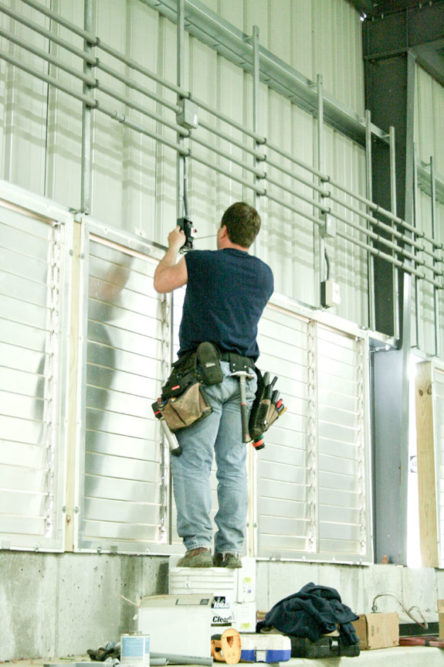Whether it’s natural or mechanical, barn ventilation is imperative when it comes to the welfare of dairy cattle. However, ventilation alone does not always provide the necessary air movement for cooling and comfort needs, a sensitivity that animals can intrinsically demonstrate simply by their eating habits, conception rates and milk production. Without a cooling breeze, the simple ventilation designed into a building isn’t enough. A properly designed and equipped barn will not only allow an adequate air exchange rate, but will also improve cow comfort.
To aid ventilation systems and supply the much-needed air movement, large-diameter, low-speed fans are often brought in to circulate the air required to keep cattle comfortable. Introduced to the agriculture industry over a decade ago, these fans provide an energy-efficient, low-cost alternative to installing numerous high-speed, small fans which are notorious for their short lifespan, high noise level and ineffective nature.
Cost-effectiveness
The price of comfort is not cut and dry, as the factors involved include initial investment, operation and needed maintenance. Installing durable, quality equipment can ensure increased productivity and reduce time spent meddling with faulty equipment.
As a cost-effective alternative, large-diameter, low-speed fans are specifically designed with a variable speed drive which can be adjusted as often as necessary. It’s important to note that air movement and proper ventilation should not be limited to summer use, but rather be incorporated year-round to maintain even temperatures and improve air quality.
Constant air circulation provides the much-needed air movement to help transition lactating cows through the year from hot summers to mild falls and into the cold winter months. During cooler months, reducing the velocities of large-diameter, low-speed fans will continue to improve air quality but will not cause wind chill.
Likewise, fans can be slowed as a freak rainstorm cools down a facility and then sped up again as the residual humidity presents itself.
From a technical perspective, fans ranging in size from 6 feet to 24 feet in diameter operate using a small one or two horsepower motor with specially designed airfoils with winglets created to move air effectively and evenly. The deep steady jets of air and their extensive reach combine to move air across and around cattle, providing comfort to all areas of the barn.
More recent developments of this technology allows these large fans to virtually eliminate EMI and RFI (electromagnetic and radio frequency interference) noise prevalent in older technology (and still used by some), thus causing no interference with electronic identification and robotic milking systems.
Other benefits include the reduction of flies and birds, drier alleys and reduced bacteria counts.
By improving herd health, dairymen not only maintain production through lactation cycles, but may also increase total lactations per cow and increase conception rates. Additionally, reducing the speed of these fans during cooler months allows producers to destratify the warm air created by body heat released from cattle and prevent unhealthy stagnant air from adversely affecting herd performance.
Investment and operational cost
Investing in durable equipment may at times require an increased first cost; however, this should be evaluated as an investment rather than an expense. Any capital purchase takes into consideration the return on investment.
Durable, purpose-built air movement systems will provide less “downtime” and less maintenance. Equipment that is ineffective or inoperable due to breakdowns or unscheduled maintenance or repairs will take away valuable time and resources at the most inopportune times.
When considering the purchase of an air movement system, the equipment needs to demonstrate an ability to maximize the possible return on investment. While evaluating minimized operating costs, don’t limit that to actual costs of operation. Consider as well the labor involved in daily operation, ease of use and purpose of use.
A year-round benefit, as stated earlier, will provide a year-round return on investment. Couple these factors with minimized labor expense and longer equipment life; the return on investment begins to shorten and justifies the upfront costs with the right equipment. Utilizing well engineered large-diameter, low-speed fans provides impressive comfort along with significant energy savings.
For example, James Woodall of Woodall Farms in Lewisburg, Kentucky, needed an inexpensive way to keep his 650-head dairy herd comfortable. It was essential to Woodall to find an effective way to reduce heat stress in order to keep his herd healthy and productive. Woodall previously used turbo fans, which only cooled air in a small, direct stream.
In an attempt to alleviate the discomfort, he installed 25 24-foot large-diameter fans throughout the freestall barn, milking parlor and compost barn. As a result, Woodall’s herd has experienced fewer respiratory problems and a 10-pound increase per head during the summer months.
“I was cooling 150 cows with the turbo fans for $3,500 a month,” said Woodall. “Now I am cooling 650 cows for $1,900 a month.” The energy-efficient technology and improved efficiency also qualified Woodall for a 25 percent energy grant from the state.
The most advanced large-diameter, low-speed fans are engineered to meet the demands of modern dairies, including:
• Purpose-built gear boxes that require no maintenance and are not vented ensure longer equipment life
• VFD placement on the motor platform eliminates EFI and RFI concerns
• Larger output shafts that offer stationary hub design to integrate equipment such as lights and observation cameras
• Single-point operation stations for multiple units
• Factory designed thermostatic control for year-round use
When considering ventilation, the primary purpose is cow comfort and herd health. Improvements in such technology have led to reduced expenses and increased effectiveness. By increasing the efficiency of your daily tasks with reduced concern of breakdown or maintenance, your operation is more efficient, more productive and more profitable. The proper equipment takes barn ventilation and cow comfort to a new, more profitable level. PD
References omitted due to space but are available upon request to editor@progressivedairy.com .
PHOTO
Installing durable, quality equipment can ensure increased productivity and reduce time spent meddling with faulty equipment. Photo by PD staff.

Adam Hatton
Big Ass Fans
adam@bigassfans.com







